Electrochemical Properties of PEDOT:PSS/Graphene Conductive Layers in Artificial Sweat
Abstract
:1. Introduction
2. Materials and Methods
3. Results and Discussion
3.1. Characterization of PEDOT:PSS/Graphene Layers
3.2. Charge Transfer through the PEDOT:PSS/Graphene Layers in Artificial Sweat
3.3. Electrochemical Stability
4. Conclusions
Author Contributions
Funding
Institutional Review Board Statement
Informed Consent Statement
Data Availability Statement
Conflicts of Interest
References
- Dauzon, E.; Mansour, A.E.; Niazi, M.R.; Munir, R.; Smilgies, D.-M.; Sallenave, X.; Plesse, C.; Goubard, F.; Amassian, A. Conducting and Stretchable PEDOT:PSS Electrodes: Role of Additives on Self-Assembly, Morphology, and Transport. ACS Appl. Mater. Interfaces 2019, 11, 17570–17582. [Google Scholar] [CrossRef] [PubMed]
- Li, Z.; Gong, L. Research Progress on Applications of Polyaniline (PANI) for Electrochemical Energy Storage and Conversion. Materials 2020, 13, 548. [Google Scholar] [CrossRef] [PubMed]
- Kouhnavard, M.; Yifan, D.; D’ Arcy, J.M.; Mishra, R.; Biswas, P. Highly Conductive PEDOT Films with Enhanced Catalytic Activity for Dye-Sensitized Solar Cells. Sol. Energy 2020, 211, 258–264. [Google Scholar] [CrossRef]
- Kaur, G.; Kaur, A.; Kaur, H. Review on Nanomaterials/Conducting Polymer-Based Nanocomposites for the Development of Biosensors and Electrochemical Sensors. Polym. Plast. Technol. Mater. 2020, 60, 502–519. [Google Scholar] [CrossRef]
- Abd-Wahab, F.; Abdul Guthoos, H.F.; Wan Salim, W.W.A. Solid-State rGO-PEDOT: PSS Transducing Material for Cost-Effective Enzymatic Sensing. Biosensors 2019, 9, 36. [Google Scholar] [CrossRef] [PubMed]
- El-Said, W.A.; Abdelshakour, M.; Choi, J.-H.; Choi, J.-W. Application of Conducting Polymer Nanostructures to Electrochemical Biosensors. Molecules 2020, 25, 307. [Google Scholar] [CrossRef] [PubMed]
- Dubey, N.; Kushwaha, C.S.; Shukla, S.K. A review on electrically conducting polymer bionanocomposites for biomedical and other applications. Int. J. Polym. Mater. Polym. Biomater. 2019, 69, 709–727. [Google Scholar] [CrossRef]
- Gueye, M.N.; Carella, A.; Faure-Vincent, J.; Demadrille, R.; Simonato, J.-P. Progress in Understanding Structure and Transport Properties of PEDOT-Based Materials: A Critical Review. Prog. Mater. Sci. 2020, 108, 100616. [Google Scholar] [CrossRef]
- Yağci, Ö.; Özdemir, O.K. Improving the Electrical Conductivity and Electrochemical Properties of PEDOT:PSS Thin Films by Ca and Mg Doping. Polym. Bull. 2022, 79, 11493–11509. [Google Scholar] [CrossRef]
- Zhang, X.; Yang, W.; Zhang, H.; Xie, M.; Duan, X. PEDOT:PSS: From conductive polymers to sensors. Nanotechnol. Precis. Eng. 2021, 4, 045004. [Google Scholar] [CrossRef]
- Ong, G.L.; Ong, T.S.; Yap, S.L.; Liaw, D.-J.; Tou, T.Y.; Yap, S.S.; Nee, C.H. A Brief Review of Nanoparticles-Doped PEDOT:PSS Nanocomposite for OLED and OPV. Nanotechnol. Rev. 2022, 11, 1870–1889. [Google Scholar] [CrossRef]
- Aleksandrova, M.; Videkov, V.; Ivanova, R.; Singh, A.K.; Thool, G.S. Highly Flexible, Conductive, and Transparent PEDOT:PSS/Au/PEDOT:PSS Multilayer Electrode for Optoelectronic Devices. Mater. Lett. 2016, 174, 204–208. [Google Scholar] [CrossRef]
- He, X.; Shi, J.; Hao, Y.; Wang, L.; Qin, X.; Yu, J. PEDOT:PSS/CNT Composites Based Ultra-Stretchable Thermoelectrics and Their Application as Strain Sensors. Compos. Commun. 2021, 27, 100822. [Google Scholar] [CrossRef]
- Jayaram, A.K.; Pitsalidis, C.; Tan, E.; Moysidou, C.-M.; De Volder, M.F.L.; Kim, J.-S.; Owens, R.M. 3D Hybrid Scaffolds Based on PEDOT:PSS/MWCNT Composites. Front. Chem. 2019, 7, 636. [Google Scholar] [CrossRef]
- Moyseowicz, A.; Minta, D.; Gryglewicz, G. Conductive Polymer/Graphene-based Composites for Next Generation Energy Storage and Sensing Applications. ChemElectroChem 2023, 10, e202201145. [Google Scholar] [CrossRef]
- Wu, Y.; Tang, H.; Wang, L.; Zong, Y.; Jia, J.; Sun, L.; Niu, K. Temperature-insensitive stretchable conductors based on hierarchical double-layer graphene Foams/PEDOT:PSS networks. Compos. Sci. Technol. 2023, 242, 110190. [Google Scholar] [CrossRef]
- Zhao, Z.-C.; Ding, S.-T.; Wen, X.-H.; Ma, H.-P.; Zhao, X.-F. 3D tubular graphene sponge/PEDOT:PSS based stretchable and flexible device for noninterfering pressure-temperature detection. Sens. Actuators A Phys. 2023, 360, 114544. [Google Scholar] [CrossRef]
- Rajendran, J.; Shetty, B.H.; Ganapathy, D.; Murugan, P.; Atchudan, R.; Umapathy, D.; Khosla, A.; Sundramoorthy, A.K. Thermally Expanded Graphite Incorporated with PEDOT:PSS Based Anode for Microbial Fuel Cells with High Bioelectricity Production J. Electrochem. Soc. 2022, 69, 017515. [Google Scholar] [CrossRef]
- Jebur, S.K.; Braihi, A.J.; Hassan, A.S. Graphene effects on the structural, morphological and optical properties of PEDOT:PSS thin films. Mater. Today Proc. 2022, 49, 2733–2740. [Google Scholar] [CrossRef]
- Eawwiboonthanakit, N.; Jaafar, M.; Ahmad, Z.; Ohtake, N.; Lila, B. Fabrication of PEDOT:PSS/graphene conductive ink printed on flexible substrate. Solid State Phenom. 2017, 264, 70–73. [Google Scholar] [CrossRef]
- Soltani-Kordshuli, F.; Zabihi, F.; Eslamian, M. Graphene-doped PEDOT:PSS nanocomposite thin films fabricated by conventional and substrate vibration-assisted spray coating (SVASC). Eng. Sci. Technol. Int. J. 2016, 19, 1216–1223. [Google Scholar] [CrossRef]
- Carey, T.; Jones, C.; Le Moal, F.; Deganello, D.; Torrisi, F. Spray-Coating Thin Films on Three-Dimensional Surfaces for a Semitransparent Capacitive-Touch Device. ACS Appl. Mater. Interfaces 2018, 10, 19948–19956. [Google Scholar] [CrossRef]
- Yang, X.; Pei, W.; Wei, C.; Yang, X.; Zhang, H.; Wang, Y.; Yuan, M.; Gui, Q.; Liu, Y.; Wang, Y.; et al. Chemical polymerization of conducting polymer poly(3,4-ethylenedioxythiophene) onto neural microelectrodes. Sens. Actuators A Phys. 2023, 349, 114022. [Google Scholar] [CrossRef]
- Castagnola, V.; Bayon, C.; Descamps, E.; Bergaud, C. Morphology and conductivity of PEDOT layers produced by different electrochemical routes. Synth. Met. 2014, 189, 7–16. [Google Scholar] [CrossRef]
- Koutsouras, D.A.; Gkoupidenis, P.; Stolz, C.; Subramanian, V.; Malliaras, G.G.; Martin, D.C. Impedance Spectroscopy of Spin-Cast and Electrochemically Deposited PEDOT:PSS Films on Microfabricated Electrodes with Various Areas. ChemElectroChem 2017, 4, 2321–2327. [Google Scholar] [CrossRef]
- Wustoni, S.; Saleh, A.; El-Demellawi, J.K.; Koklu, A.; Hama, A.; Druet, V.; Wehbe, N.; Zhang, Y.; Inal, S. MXene Improves the Stability and Electrochemical Performance of Electropolymerized PEDOT Films. APL Mater. 2020, 8, 121105. [Google Scholar] [CrossRef]
- Pan, Q.; Wu, Q.; Sun, Q.; Zhou, X.; Cheng, L.; Zhang, S.; Yuan, Y.; Zhang, Z.; Ma, J.; Zhang, Y.; et al. Biomolecule-Friendly Conducting PEDOT Interface for Long-Term Bioelectronic Devices. Sens. Actuators B Chem. 2022, 373, 132703. [Google Scholar] [CrossRef]
- Mousavi, H.; Ferrari, L.M.; Whiteley, A.; Ismailova, E. Kinetics and Physicochemical Characteristics of Electrodeposited PEDOT:PSS Thin Film Growth. Adv. Electron. Mater. 2023, 9, 2201282. [Google Scholar] [CrossRef]
- Tian, F.; Yu, J.; Wang, W.; Zhao, D.; Cao, J.; Zhao, Q.; Wang, F.; Yang, H.; Wu, Z.; Xu, J.; et al. Design of adhesive conducting PEDOT-MeOH:PSS/PDA neural interface via electropolymerization for ultrasmall implantable neural microelectrodes. J. Colloid Interface Sci. 2023, 638, 339–348. [Google Scholar] [CrossRef]
- Sriprachuabwong, C.; Karuwan, C.; Wisitsorrat, A.; Phokharatkul, D.; Lomas, T.; Sritongkhamb, P.; Tuantranont, A. Inkjet-printed graphene-PEDOT:PSS modified screen printed carbon electrode for biochemical sensing. J. Mater. Chem. 2012, 22, 5478–5485. [Google Scholar] [CrossRef]
- Ge, Y.; Jalili, R.; Wang, C.; Zheng, T.; Chao, Y.; Wallace, G.G. A robust free-standing MoS2/poly(3,4-ethylenedioxythiophene):poly (styrenesulfonate) film for supercapacitor applications. Electrochim. Acta 2017, 235, 348–355. [Google Scholar] [CrossRef]
- Boehler, C.; Oberueber, F.; Schlabach, S.; Stieglitz, T.; Asplund, M. Long-term stable adhesion for conducting polymers in biomedical applications: IrOx and nanostructured platinum solve the chronic challenge. ACS Appl. Mater. Interfaces 2017, 9, 189–197. [Google Scholar] [CrossRef]
- Schander, A.; Tesmann, T.; Strokov, S.; Stemmann, H.; Kreiter, A.K.; Lang, W. In-vitro evaluation of the long-term stability of PEDOT:PSS coated microelectrodes for chronic recording and electrical stimulation of neurons. In Proceedings of the Annual International Conference of the IEEE Engineering in Medicine and Biology Society (EMBC), Orlando, FL, USA, 16–20 August 2016; pp. 6174–6177. [Google Scholar] [CrossRef]
- Inoue, A.; Yuk, H.; Lu, B.; Zhao, X. Strong Adhesion of Wet Conducting Polymers on Diverse Substrates. Sci. Adv. 2020, 6, eaay5394. [Google Scholar] [CrossRef]
- Abdullayeva, N.; Sankir, M. Influence of Electrical and Ionic Conductivities of Organic Electronic Ion Pump on Acetylcholine Exchange Performance. Materials 2017, 10, 586. [Google Scholar] [CrossRef]
- Stefaniak, A.B.; Harvey, C.J. Dissolution of Materials in Artificial Skin Surface Film Liquids. Vitr. Toxicol. 2006, 20, 1265–1283. [Google Scholar] [CrossRef]
- Nasera, S.A.; Hameed, A.A.; Husseinc, M.A. Corrosion Behavior of Some Jewelries in Artificial Sweat. AIP Conf. Proc. 2020, 2213, 020030. [Google Scholar] [CrossRef]
- Aleksandrova, M.; Tomov, R.; Mateev, V.; Iliev, I. Spray Deposition of Conjugated Polymer/Graphene Ink as an Electrode in Future Chemical Biosensing Devices. In Proceedings of the 33rd IEEE International Conference on Microelectronics MIEL’23, Niš, Serbia, 16–18 October 2023. [Google Scholar]
- Kumar, R.S.N.; Ramirez, A.V.; Verding, P.; Nivelle, P.; Renner, F.; D’Haen, J.; Deferme, W. Deposition of ultra-thin coatings by a nature-inspired Spray-on-Screen technology. Commun. Eng. 2023, 2, 42. [Google Scholar] [CrossRef]
- Zhou, J.; Anjum, D.H.; Chen, L.; Xu, X.; Ventura, I.A.; Jiang, L.; Lubineau, G. The temperature-dependent microstructure of PEDOT/PSS films: Insights from morphological, mechanical, and electrical analyses. J. Mater. Chem. C 2014, 2, 9903–9910. [Google Scholar] [CrossRef]
- Boehler, C.; Carli, S.; Fadiga, L.; Stieglitz, T.; Asplund, M. Tutorial: Guidelines for standardized performance tests for electrodes intended for neural interfaces and bioelectronics. Nat. Protoc. 2020, 15, 3557–3578. [Google Scholar] [CrossRef]
- Wu, Z.-S.; Liu, Z.; Parvez, K.; Feng, X.; Müllen, K. Ultrathin Printable Graphene Supercapacitors with AC Line-Filtering Performance. Adv. Mater. 2015, 27, 3669–3675. [Google Scholar] [CrossRef]
- Sakthinathan, I.; Yamasaki, N.; Barreca, D.; Maccato, C.; Ueda, T.; McCormac, T. Wells-Dawson Type Polyoxometalate, [S2W18O62]4−-Doped Poly(3,4-ethylenedioxythiophene) Films: Voltammetric Behaviour and Applications to Selective Bromate Detection. Electrochim. Acta 2023, 462, 142689. [Google Scholar] [CrossRef]
- Magar, H.S.; Hassan, R.Y.A.; Mulchandani, A. Electrochemical Impedance Spectroscopy (EIS): Principles, Construction, and Biosensing Applications. Sensors 2021, 21, 6578. [Google Scholar] [CrossRef] [PubMed]
- El-Azazy, M.; Min, M.; Annus, P. Electrochemical Impedance Spectroscopy; IntechOpen: London, UK, 2020. [Google Scholar] [CrossRef]
- Nemiwal, M.; Zhang, T.C.; Kumar, D. Graphene-based electrocatalysts: Hydrogen evolution reactions and overall water splitting. Int. J. Hydrogen Energy 2021, 46, 21401–21418. [Google Scholar] [CrossRef]
- Tsai, T.C.; Chang, H.-C.; Chen, C.-H.; Huang, Y.-C.; Whang, W.-T. A facile dedoping approach for effectively tuning thermoelectricity and acidity of PEDOT:PSS films. Org. Electron. 2014, 15, 641–645. [Google Scholar] [CrossRef]
- Da Silva, L.M.; De Faria, L.A.; Boodts, J.F.C. Determination of the Morphology Factor of Oxide Layers. Electrochim. Acta 2001, 47, 395–403. [Google Scholar] [CrossRef]
- Cui, X.; Martin, D.C. Electrochemical Deposition and Characterization of Poly(3,4-ethylenedioxythiophene) on Neural Microelectrode Arrays. Sens. Actuators B Chem. 2003, 89, 92–102. [Google Scholar] [CrossRef]
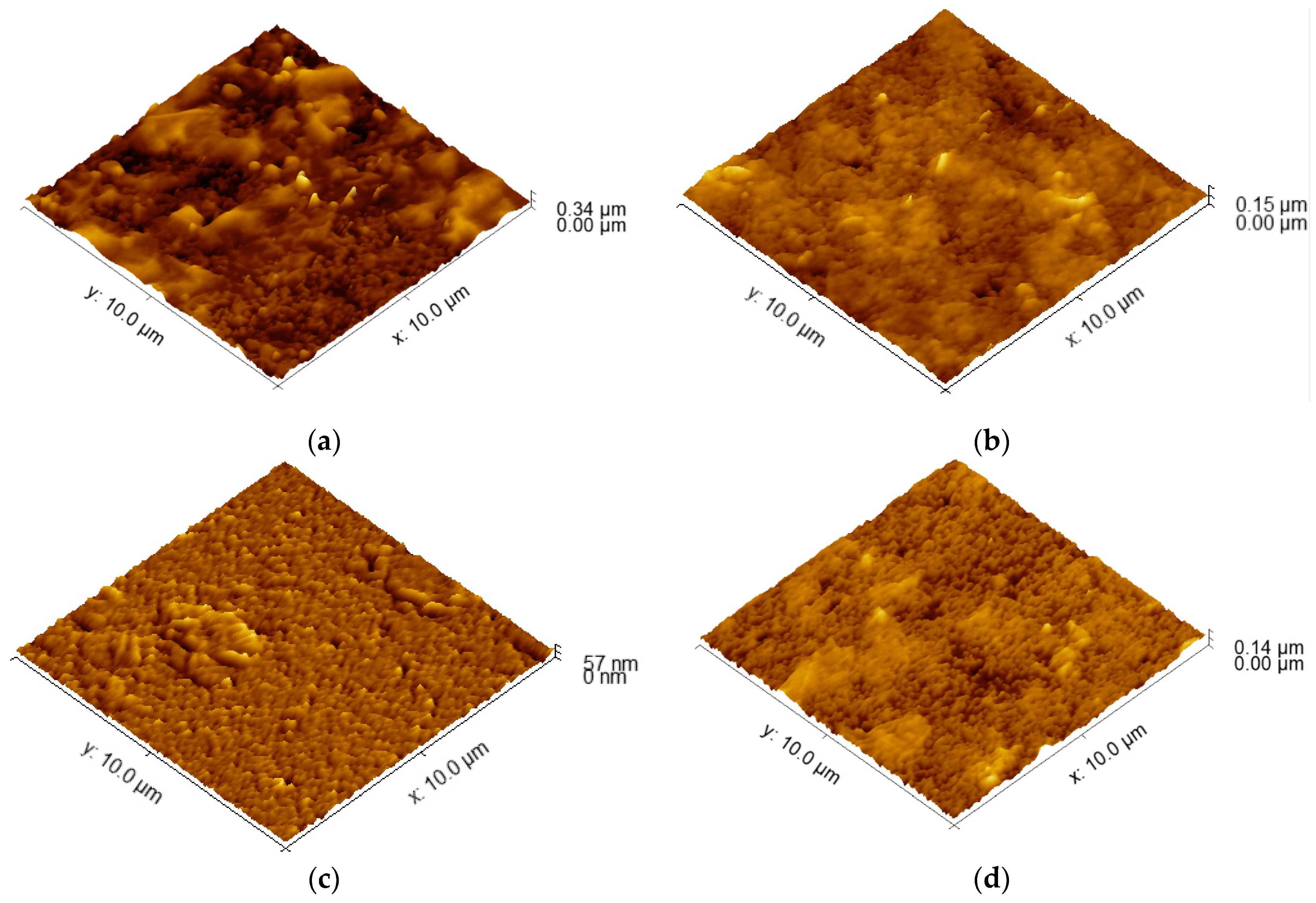
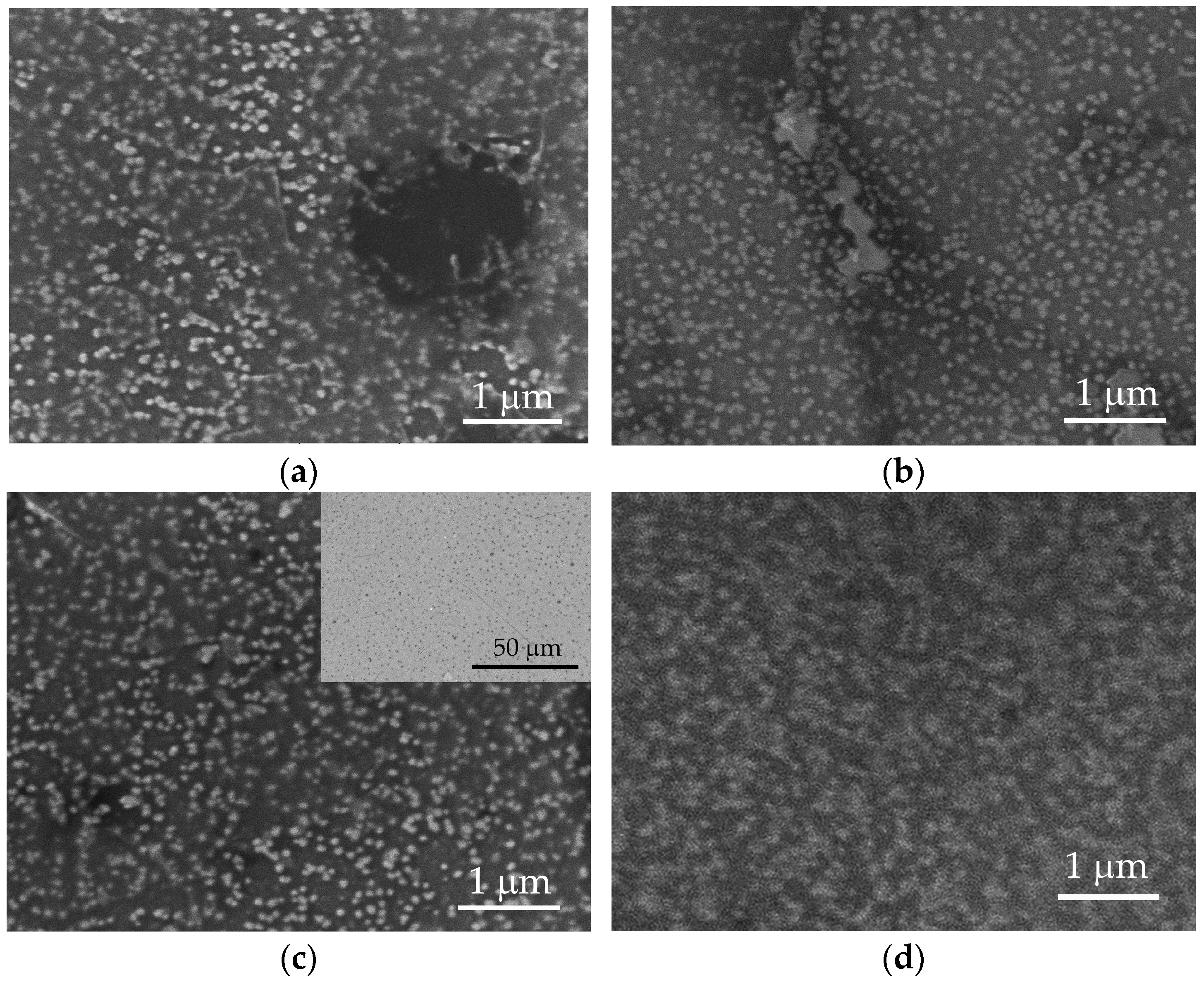
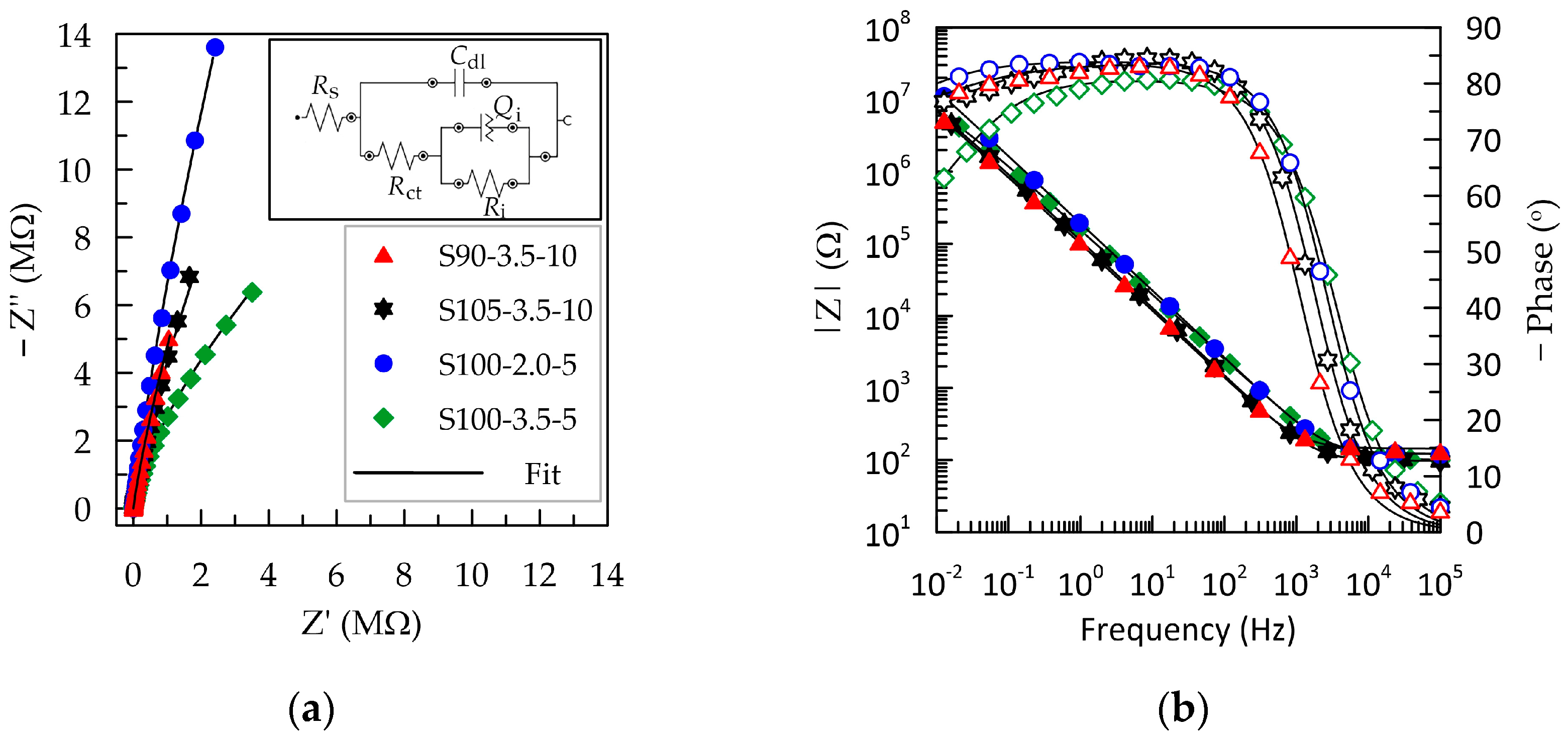

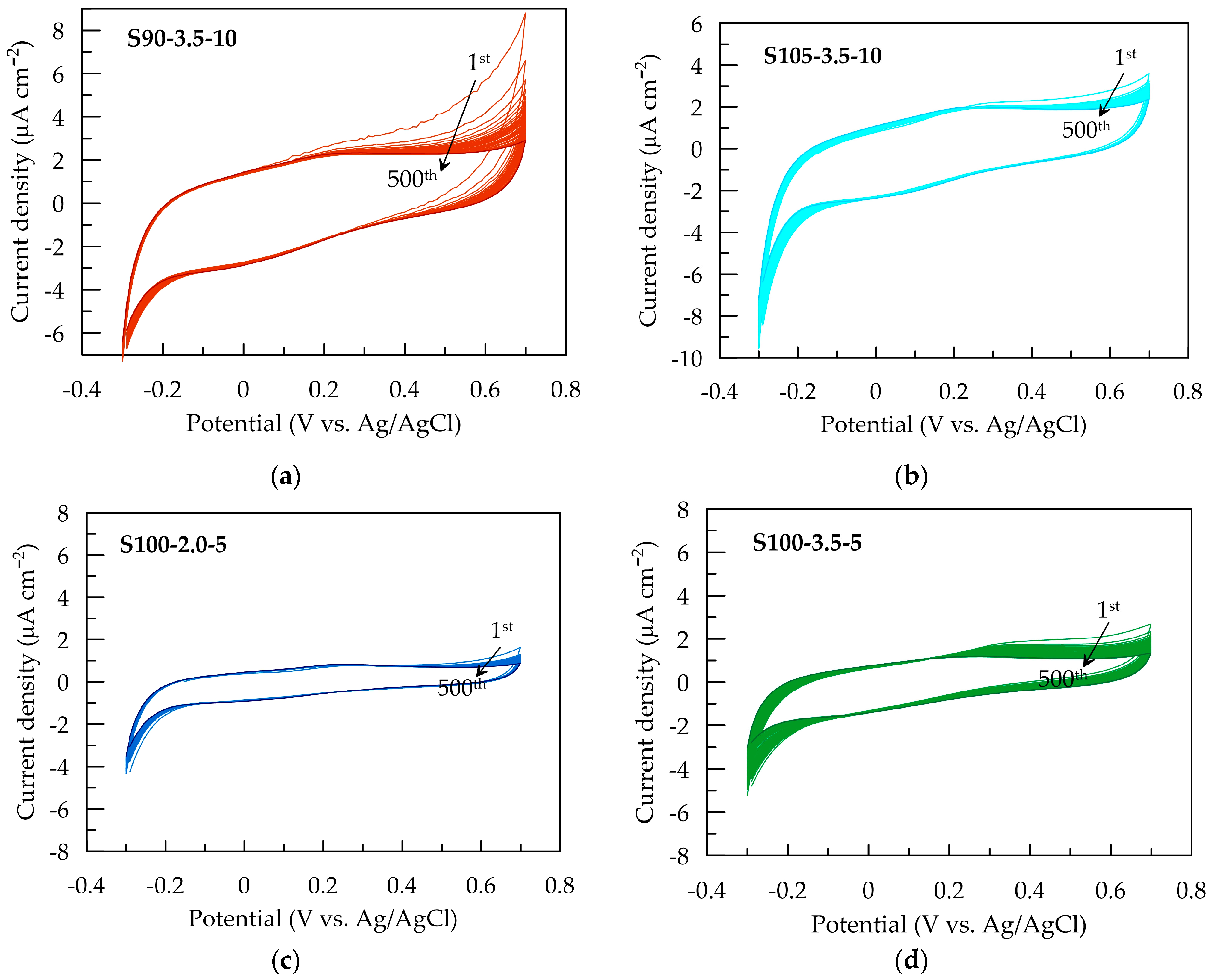
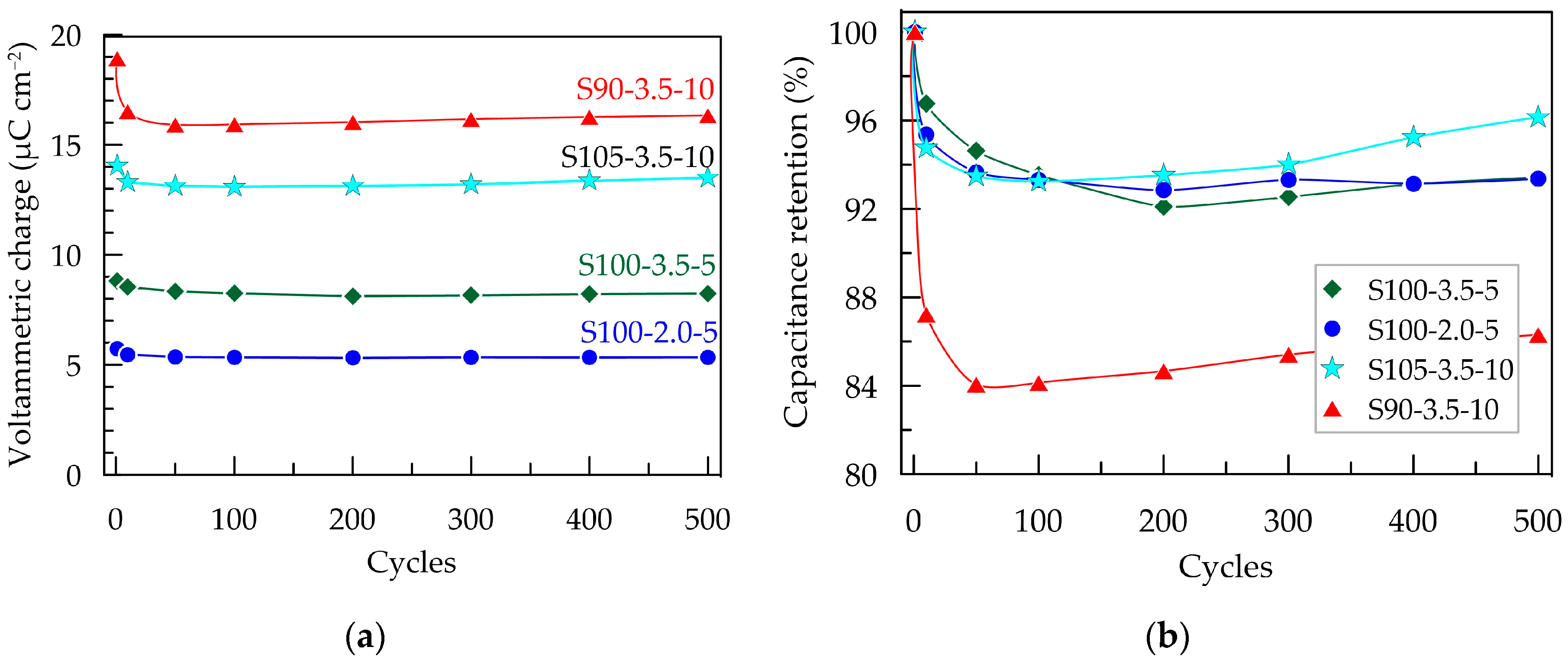

| Sample | Temperature, °C | Pressure, Bar | Number of Passes | Thickness, µm | Rs, Ω/sq | ΔRsd, Ω/sq | Roughness, nm |
|---|---|---|---|---|---|---|---|
| S90-3.5-10 | 90 | 3.5 | 10 | 3.25 ± 0.05 | 117.9 | 57.6 | 35.7 ± 6.8 |
| S105-3.5-10 | 105 | 3.5 | 10 | 1.8 ± 0.05 | 90.3 | 29.7 | 8.3 ± 0.8 |
| S100-2.0-5 | 100 | 2.0 | 5 | 1.25 ± 0.05 | 51.3 | 5.1 | 9.1 ± 2.3 |
| S100-3.5-5 | 100 | 3.5 | 5 | 1.00 ± 0.05 | 111.6 | 49.4 | 9.2 ± 0.7 |
| Sample | fcut-off, kHz | Rs, Ω | Rct, Ω | Rp, MΩ | Qi, µF sn | n | Cdl, nF | χ2 |
|---|---|---|---|---|---|---|---|---|
| S90-3.5-10 | 0.96 | 137.8 | 80.6 | 93.8 | 1.23 | 0.865 | 641.6 | 0.0005 |
| S105-3.5-10 | 1.55 | 97.8 | 192 | 95.7 | 0.927 | 0.831 | 764.4 | 0.0007 |
| S100-2.0-5 | 2.31 | 114.7 | 30.6 | 220.7 | 0.767 | 0.912 | 175.2 | 0.00009 |
| S100-3.5-5 | 3.21 | 101 | 146.9 | 24.86 | 0.961 | 0.82 | 342.6 | 0.0003 |
| Sample | QCV, µC cm−2 | CCV, mF m−2 |
|---|---|---|
| S90-3.5-10 | 18.93 ± 2.41 | 122.0 ± 6.2 |
| S105-3.5-10 | 14.05 ± 1.02 | 94.2 ± 4.6 |
| S100-2.0-5 | 5.51 ± 1.14 | 54.3 ± 2.9 |
| S100-3.5-5 | 8.82 ± 0.97 | 105.6 ± 6.3 |
Disclaimer/Publisher’s Note: The statements, opinions and data contained in all publications are solely those of the individual author(s) and contributor(s) and not of MDPI and/or the editor(s). MDPI and/or the editor(s) disclaim responsibility for any injury to people or property resulting from any ideas, methods, instructions or products referred to in the content. |
© 2023 by the authors. Licensee MDPI, Basel, Switzerland. This article is an open access article distributed under the terms and conditions of the Creative Commons Attribution (CC BY) license (https://creativecommons.org/licenses/by/4.0/).
Share and Cite
Tzaneva, B.; Aleksandrova, M.; Mateev, V.; Stefanov, B.; Iliev, I. Electrochemical Properties of PEDOT:PSS/Graphene Conductive Layers in Artificial Sweat. Sensors 2024, 24, 39. https://doi.org/10.3390/s24010039
Tzaneva B, Aleksandrova M, Mateev V, Stefanov B, Iliev I. Electrochemical Properties of PEDOT:PSS/Graphene Conductive Layers in Artificial Sweat. Sensors. 2024; 24(1):39. https://doi.org/10.3390/s24010039
Chicago/Turabian StyleTzaneva, Boriana, Mariya Aleksandrova, Valentin Mateev, Bozhidar Stefanov, and Ivo Iliev. 2024. "Electrochemical Properties of PEDOT:PSS/Graphene Conductive Layers in Artificial Sweat" Sensors 24, no. 1: 39. https://doi.org/10.3390/s24010039
APA StyleTzaneva, B., Aleksandrova, M., Mateev, V., Stefanov, B., & Iliev, I. (2024). Electrochemical Properties of PEDOT:PSS/Graphene Conductive Layers in Artificial Sweat. Sensors, 24(1), 39. https://doi.org/10.3390/s24010039








